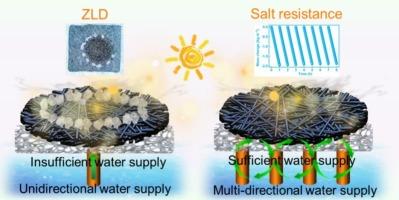太阳能驱动聚吡咯装饰聚酯过滤棉,高效脱盐和零液体排放
IF 9.8
1区 工程技术
Q1 ENGINEERING, CHEMICAL
引用次数: 0
摘要
界面太阳能蒸发技术(ISET)有望通过太阳能驱动的海水淡化来缓解淡水短缺。然而,太阳能蒸发器的进步,采用直接的方法来提高蒸发速率(ER),提高耐盐性,并促进盐晶体的收集,对ISET提出了相当大的挑战。在这项研究中,我们开发了一种名为聚吡咯-聚酯过滤棉(PPy-PFC)的光热材料(PTM),该材料是通过简单的溶液浸泡技术将聚吡咯(PPy)涂在聚酯过滤棉(PFC)上获得的。py - pfc有效地降低了水的蒸发焓,在1太阳强度下获得了令人印象深刻的2.44 kg m−2 h−1的ER。聚酯纤维束(PFB)包含垂直供水通道,并作为水泵。当使用多个PFBs向PPy-PFC输送水时,它可以持续蒸发20% wt%的盐水,ER为1.95 kg m−2 h−1。这种卓越的耐盐性能归功于多个PFBs提供的充足供水,这有助于盐离子的扩散回流。此外,通过在PPy-PFC的中心放置单个PFB,构建了单向盐水流动蒸发器。结晶盐在单个PFB周围形成,半径为1.5 cm,实现零液体放电(ZLD)。本研究提出了一种设计太阳能蒸发器的新策略,通过降低水蒸发焓,通过充足的供水来增强盐阻力,并通过建立单向盐水流动通道来收集盐晶体,从而提高ER。本文章由计算机程序翻译,如有差异,请以英文原文为准。

Solar-driven polypyrrole-decorated polyester filter cotton for efficient desalination and zero liquid discharge
Interfacial solar evaporation technology (ISET) holds significant promise for mitigating freshwater scarcity through solar-driven desalination. However, the advancement of solar evaporators that employ straightforward methods to enhance the evaporation rate (ER), improve salt resistance, and facilitate the collection of salt crystals poses a considerable challenge for ISET. In this study, we developed a photothermal material (PTM) named polypyrrole-polyester filter cotton (PPy-PFC), achieved by coating polypyrrole (PPy) onto polyester filter cotton (PFC) using a simple solution immersion technique. The PPy-PFC effectively reduces the enthalpy of water evaporation, resulting in an impressive ER of 2.44 kg m−2 h−1 under 1-solar intensity. The polyester fiber bundle (PFB) incorporates vertical water supply channels and acts as a water pump. When multiple PFBs are employed to deliver water to the PPy-PFC, it can consistently evaporate 20 wt% saltwater with an ER of 1.95 kg m−2 h−1. This remarkable salt resistance performance is attributed to the ample water supply delivered by the multiple PFBs, which facilitates the diffusion backflow of salt ions. Additionally, by positioning a single PFB at the center of the PPy-PFC, a unidirectional saltwater-flowing evaporator is constructed. Crystallized salt forms around the single PFB with a radius of 1.5 cm, achieving zero liquid discharge (ZLD). This study presents a novel strategy for designing solar evaporators that improve ER by reducing the enthalpy of water evaporation, enhancing salt resistance through sufficient water supply, and enabling the collection of salt crystals via the establishment of a unidirectional saltwater-flowing channel.
求助全文
通过发布文献求助,成功后即可免费获取论文全文。
去求助
来源期刊

Desalination
工程技术-工程:化工
CiteScore
14.60
自引率
20.20%
发文量
619
审稿时长
41 days
期刊介绍:
Desalination is a scholarly journal that focuses on the field of desalination materials, processes, and associated technologies. It encompasses a wide range of disciplines and aims to publish exceptional papers in this area.
The journal invites submissions that explicitly revolve around water desalting and its applications to various sources such as seawater, groundwater, and wastewater. It particularly encourages research on diverse desalination methods including thermal, membrane, sorption, and hybrid processes.
By providing a platform for innovative studies, Desalination aims to advance the understanding and development of desalination technologies, promoting sustainable solutions for water scarcity challenges.
 求助内容:
求助内容: 应助结果提醒方式:
应助结果提醒方式:


